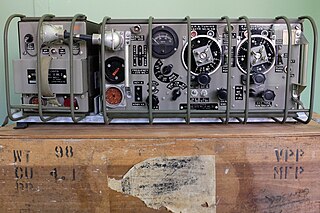 W
WClansman is the name of a combat net radio system (CNR) used by the British Army from 1976 to 2010.
 W
WThe Defence High Frequency Communications Service or the DHFCS is a British military beyond line-of-sight communication system operated by the Ministry of Defence (MOD) and used predominately by the Royal Air Force, Royal Navy and British Army, as well as other authorised users.
 W
WMorgan's Hill is a 12.6 hectare biological Site of Special Scientific Interest between Calne and Devizes in Wiltshire, England. The SSSI was notified in 1951 and again in 1987.
 W
WFitted For Wireless (FFW) and Fitted For Radio (FFR) were British Army designators for vehicles equipped to carry radio equipment. Although many of these vehicles would be dedicated 'radio vans' and would have the complex and expensive radio sets installed, the intention was also that general purpose vehicles could be issued in 'FFW' state with the low-cost but time-consuming cabling and equipment mounts already prepared. The actual sets themselves could be installed later, if a new radio vehicle was required owing to damage or breakdown.
 W
WFitted For Wireless (FFW) and Fitted For Radio (FFR) were British Army designators for vehicles equipped to carry radio equipment. Although many of these vehicles would be dedicated 'radio vans' and would have the complex and expensive radio sets installed, the intention was also that general purpose vehicles could be issued in 'FFW' state with the low-cost but time-consuming cabling and equipment mounts already prepared. The actual sets themselves could be installed later, if a new radio vehicle was required owing to damage or breakdown.
Larkspur was the retrospectively adopted name of a tactical radio system used by the British Army. Its development started in the late 1940s with the first equipment being issued in the mid-1950s. It remained in service until replaced by Clansman in the late-1970s although some elements of Larkspur were still in service well into the 1980s. It was widely exported to British Commonwealth armies and other friendly nations.
 W
WThe Paraset was a small, low-power, thermionic valve CW morse code-only radio transmitter-receiver supplied to the resistance groups in France, Belgium and the Netherlands during World War II.
 W
WThe H4855 Personal Role Radio (PRR) is a small UHF transmitter-receiver issued to the British Armed Forces. It is used by the British Army, Royal Marines, Royal Navy and the Royal Air Force Regiment. The radio has a range of 500 meters, weighs 1.5 kilograms, has 256 different radio channels and a battery life of 20 hours continuous use. It allows users to communicate over short distances. Effective even through thick cover or the walls of buildings, PRR is issued to every member of an eight-strong infantry section. It is manufactured by Marconi-Selenia Communications. The PRR was originally part of the wider Bowman radio project but was hived off in October 1999 for more rapid implementation, and the first of 45,000 units formally entered service in early 2002. Operating in the 2.4 GHz band, PRR has no integrated encryption devices and does not intercommunicate with the rest of the Bowman network, but is widely acclaimed as having revolutionised intra-squad communications and small-unit tactics.
 W
WRugby Radio Station was a large radio transmission facility at Hillmorton near the town of Rugby, Warwickshire in England, situated just west of the A5 trunk road and in later years junction 18 of the M1 motorway. Part of the site was on the other side of the A5, across the border in Northamptonshire. First opened in 1926, at its height in the 1950s it was the largest radio transmitting station in the world, with a total of 57 radio transmitters, covering an area of 1600 acres. Traffic slowly dwindled from the 1980s onwards, and the site was closed between 2003 and 2007.
 W
WThe S-Phone system was a UHF duplex radiotelephone system developed during World War II for use by Special Operations Executive agents working behind enemy lines to communicate with friendly aircraft and coordinate landings and the dropping of agents and supplies. The system was composed of a "Ground" transceiver, designed by Captain Bert Lane, and an "Air" transceiver designed by Major Hobday, both of the Royal Signals.
 W
WThe wireless set No. 11 was a wireless radio transceiver used by the British Army during World War II.
 W
WThe Wireless Set No. 18 was a HF portable man-pack radio transceiver used by the British Army during World War II. Frequency coverage was 6 to 9MHz with an RF output of 0.25W. Range was up to 10 miles.
 W
WThe Wireless Set No. 19 was a Second World War mobile radio transceiver designed for use by armoured troops of the British Army.
 W
WThe Wireless Set No. 38 was a HF portable man-pack radio transceiver used by the British Army during World War II. Designed by Murphy Radio, it was a 5 valve set covering 7.4 to 9 MHz and powered by a large dry cell battery carried in a separate haversack. An AFV variant was also developed for use alongside the Wireless Set No. 19 in armoured vehicles to allow direct communication between tank commanders and infantry. In 1945, a Mk. III version was produced housed in a sealed diecast metal enclosure.
 W
WThe Wireless Set No. 62 was a British Army HF band radio transceiver. Introduced by Pye during the later part of World War II as a light-weight and waterproof replacement for the Wireless Set No. 22. Although intended as an interim design, it remained in production until 1966.